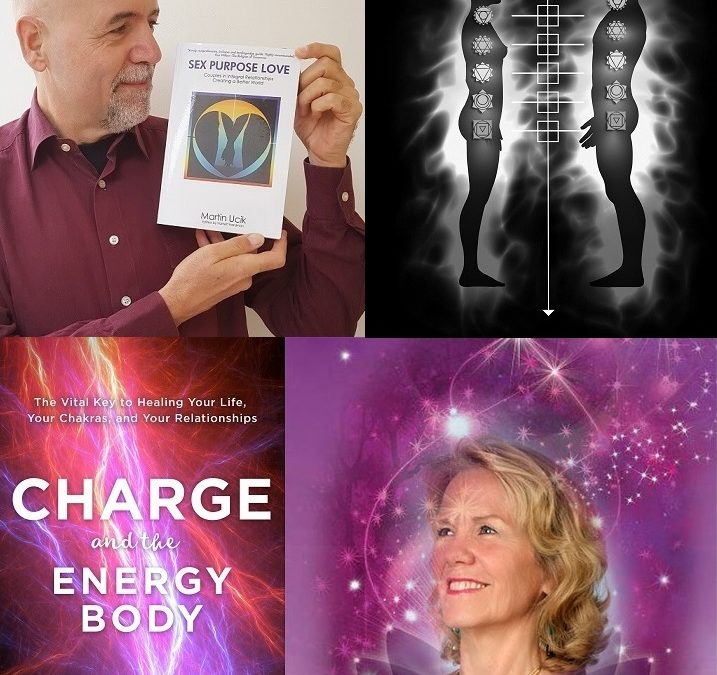Click here to download the Power Point Show.
Watch the Video at https://youtu.be/bECj_5POLX0
Anodea Judith's comprehensive work about the seven chakras provided much of the wisdom and foundation for developing the Integral Love Relationship model in Part III of my new book Sex Purpose Love, which is outlined in the images and text below. So I was excited to have a deeper exploration with her about Integrating at the Heart: Coupling at All Seven Chakras and her new book Charge and the Energy Body.
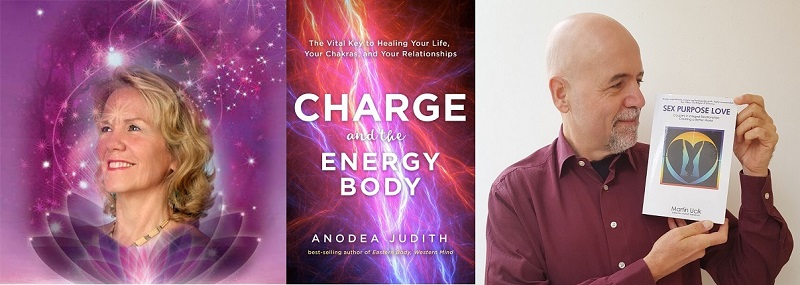
As I looked at love (and not only relationships) through an Integral lens, I realized that males and females have different desires and capacities to love in each of the four quadrants at the level of the seven Chakras.
In traditional love relationships females desire males who successfully produce, protect, and create, and males desire females with the best capacities to reproduce, care, and direct.
These three pairs of mutually compatible asymmetrical desires or love between males and females (providing in exchange for sex; safety in exchange for care; and creativity in exchange for intuition and wisdom) nicely map onto the first six of the seven chakras[iv] as summarized below, with the seventh chakra representing the differentiated unity of the couple.[v]
This dialectic of love has led to different sexual attractors and gender roles between males and females that evolved over time and are seen to this day in what I call
Asymmetric Transactional Love Relationships as shown in the image below:
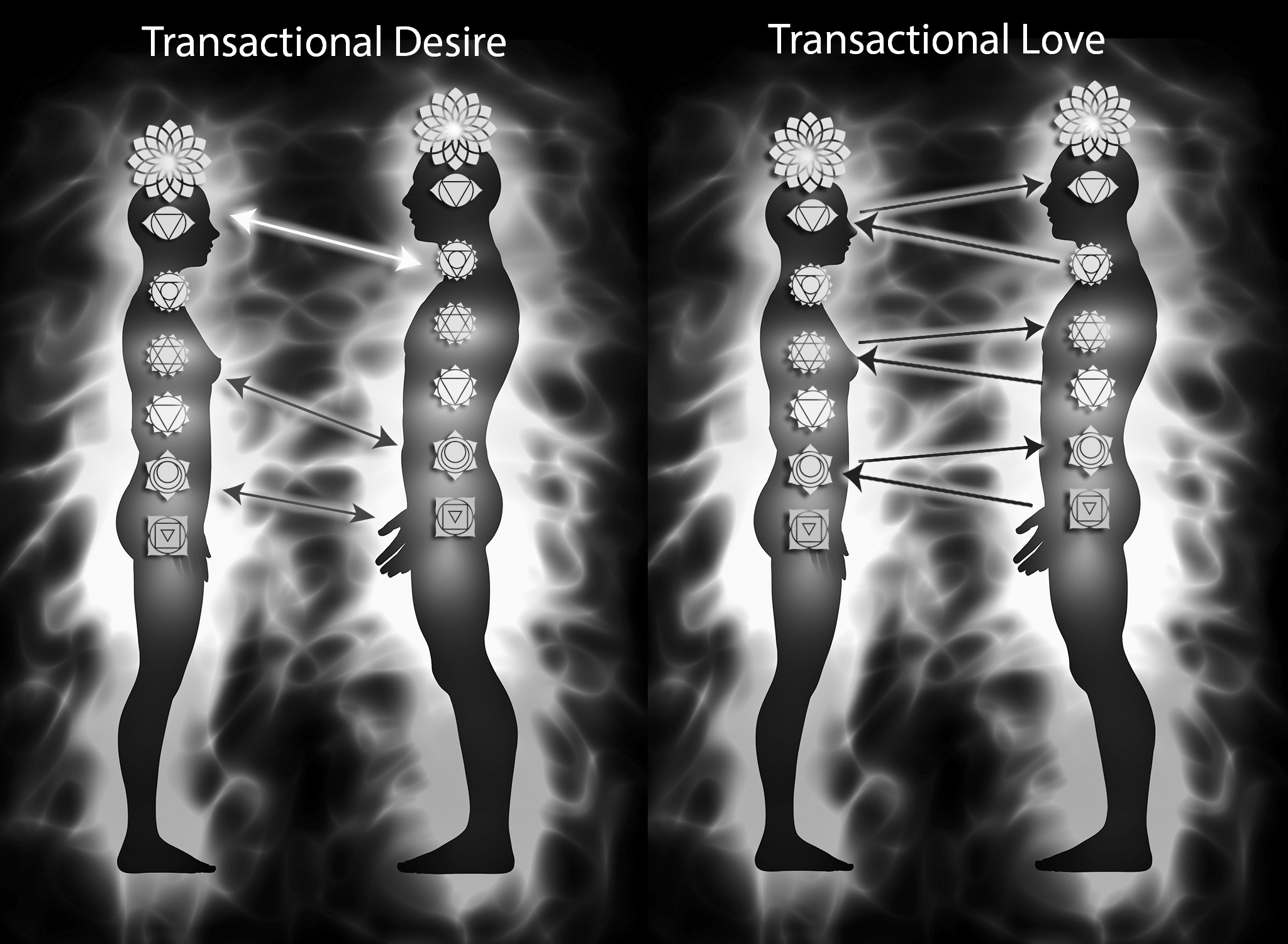
In all three instances, the love is asymmetrical and transactional, because both partners objectify each other and use each other as a means to fulfill their biologically and psychologically programmed, and culturally conditioned needs and desires.[x] We therefore also speak of desire or need-based love relationships.
Using the chakra system, we also see that the female reward for the male contribution is always located in the next higher chakra.
At the most basic “archaic” or “primal” level of our animal nature, adults desire members of the opposite sex who are physically able to produce the healthiest offspring and provide the best chances for their survival.
Females are thus attracted to strong and productive males who can provide the healthiest sperms and ongoing material resources such as food and shelter (or in modern societies money) to meet her and her children’s needs for sustenance and comfort.
Males are attracted to young, sexy, fertile females with body features that indicate good reproductive capacities such as 0.7 waist-to-hip ratio, smooth skin, shiny hair etc. This is represented by the male and female Primary Fantasies that became deeply embedded in our reptilian brain as described in Part 1. The love that is co-created when these desires are mutually met is indicated by the right side of Sternberg’s Triangle of Love with different intensities of hormonally induced infatuation and sexual passion.
Once the Primary Fantasies of males and females are met, additional desires arise for partners who make us feel good by keeping our stress hormones down and feel-good hormones up. Females become attracted to males with power, strength, and social status[i] who meet their needs for physical safety by being aggressive towards others, are benevolent towards them and their children, and who augment the female’s sense of significance through their partner’s social status, class, prestige, popularity, and power.
In contrast, males desire females who are not only sexy, but who also care for them physically and emotionally, and who value and appreciate their contributions to the safety and social status of their partner and family.
Once the needs for survival and safety are met females begin to desire males who are artistically creative, expressive, visionary, and entertaining.
On the other hand, males become attracted to females who inspire them with their wisdom, who guide them with the intuition, and who support their vision, laugh at their jokes, and challenge them to become better men for their own sake and to serve humanity better, and not just “fix them” for the woman’s personal satisfaction.[iii]
These needs and desires that lead to love when fulfilled vary along the seven stages of consciousness development as shown in the matrix below:
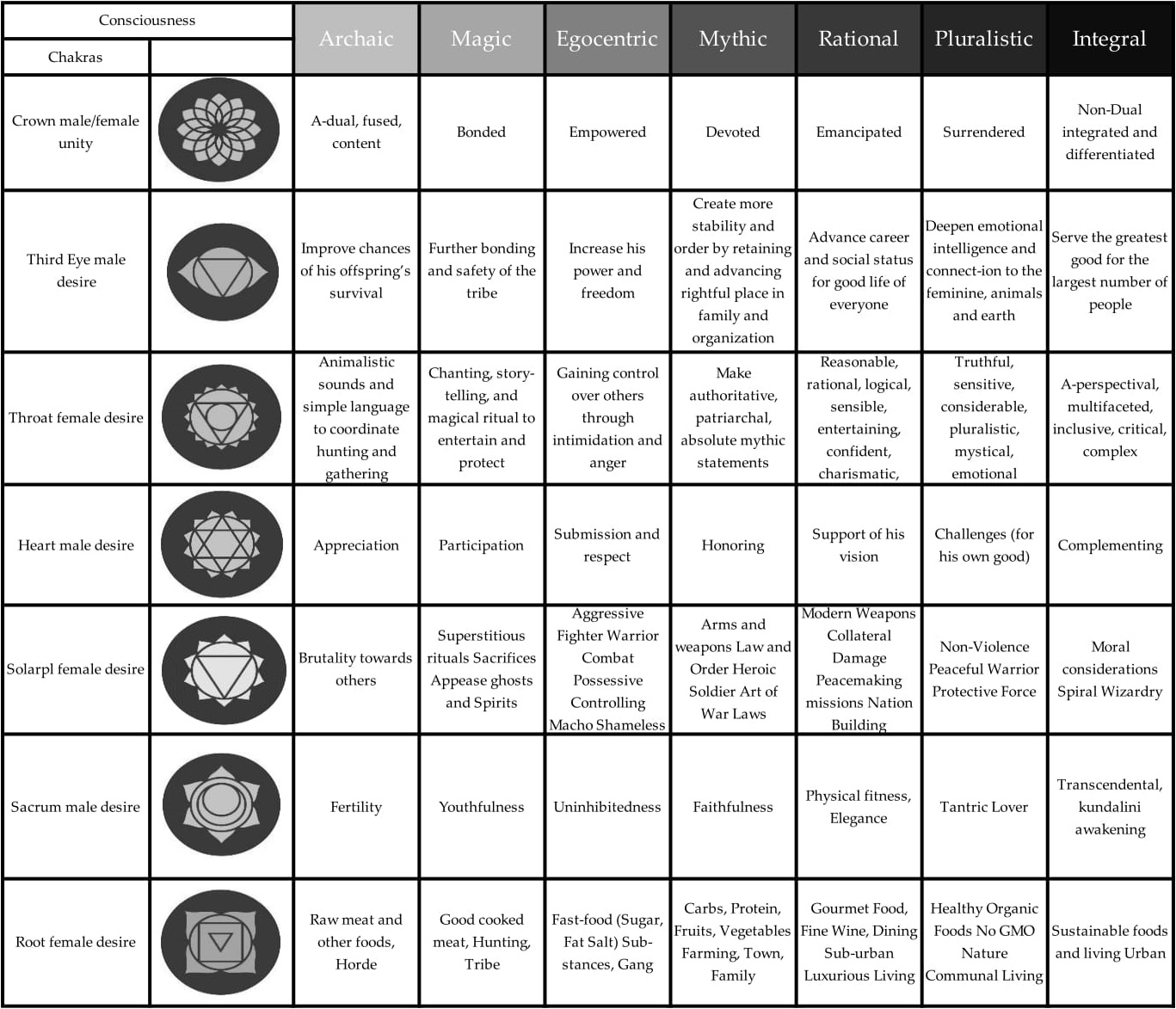
Symmetrical Transcendental Love
When we fall in love with an equal and opposite partner who shares our Transcendental Purpose a major shift takes place. Couples in these relationships move from the asymmetric dialectic of love that is driven by lack, need, and desire, to a symmetric dialectic of love.
While people who live their Transcendental Purpose are still attracted to mature partners who are financially, physically, sexually, mentally, emotionally and spiritually fit and healthy, the main attractor and sexual selection criteria, and what they ultimately fall in love with, is that which is co-created between them and offered in service to the world through combining their complementary natural talents and balancing and harmonizing their healthy feminine and masculine polarities between the four quadrants at the level of all seven chakras in a way that they could not do as individuals.
This is shown in the image below in which we see that desire and love are symmetric at the level of all level chakras.
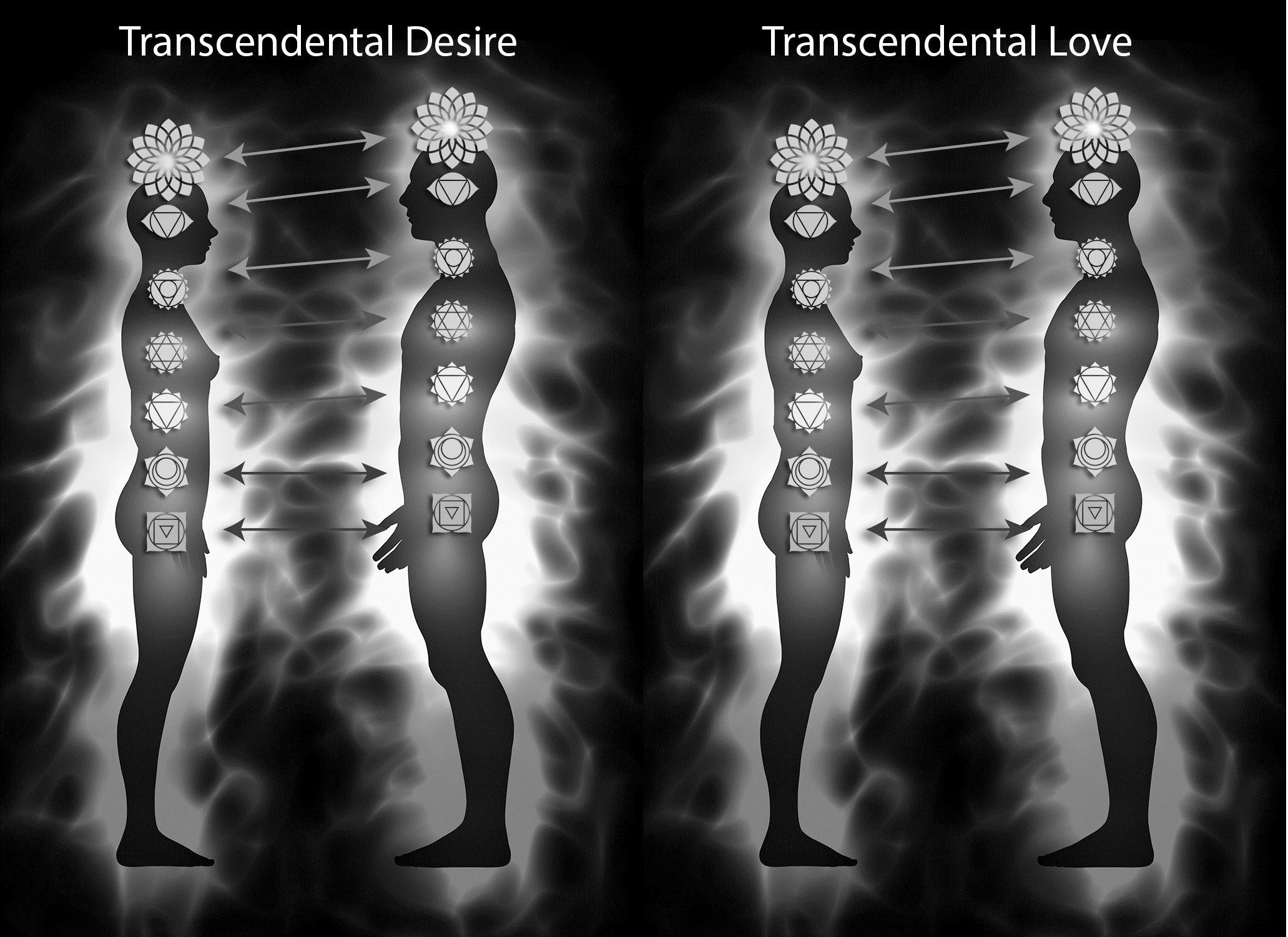
At the level of the first chakra, both partners take equal responsibilities for financially contributing to their environmentally responsible and sustainable life-style by both being success and fulfillment oriented. Even though there may be times when one partner contributes more than the other, for example, during pregnancy and child rearing, during schooling and other professional training, or during an illness or other hardship, it never becomes a one-way street in the long run or an asymmetrical need or desire.At the level of the second chakra, both partners develop the capacity to share healthy (typically monogamous) forms of sexuality between them that benefits them both. This may involve becoming more physically fit and healthier, removing psychological blocks, healing emotional wounds around their sexuality, learning tantric techniques, and practicing sacred sexuality. Sexuality is no longer used as a bargaining chip, display of power, or a means to manipulate or punish each other through withholding, but is equally pursued and enjoyed by both, while maintaining the sexual polarity by balancing feminine and masculine polarities.
Creating symmetry at these two levels moderates or even removes the Primary Fantasy as the main attractor and replaces it with equal desires, rights, and responsibilities to co-create as equal and opposite partners at the level of the first and second chakra. This may at first feel unreasonable or unappealing to males who use their money, power and status to get access to younger, sexy women. And, it may even outrage attractive females who use their looks and sexuality to get access to financially successful and powerful males, or to otherwise get what they want and have their way through playing the sex card and becoming a trophy wife. But once they experience the joy, satisfaction, power, and sexiness of sharing their Transcendental Purpose with a partner, they will not want to go back to the manipulative, unsustainable transactional love relationship that they had previously engaged in.
At the level of the third chakra, both partners bring their full power, energy, dynamism, and social status in the community they serve to the table in order to enact their shared Transcendental Purpose in the most effective way. Each of them uses their individual strengths to co-create the highest level of synergy with their opposite and equal partners.
At the level of the fourth chakra, both partners open their hearts to love and caring compassion for self and others. They co-create ever deepening levels of intimacy between them through self-validated sharing of their feelings, and by supporting each other to heal their emotional wounds. The fourth chakra is also the level where they both feel the suffering of others most prominently. Their compassion for the world at large inspires and motivates them to share and live their Transcendental Purpose with a sense of urgency in order to have the greatest possible impact in improving the well-being of others.
Connecting symmetrically at the levels of the third and fourth chakra allows women to come into their full power with their partner instead of needing to exert power over their partner or being concerned about being overpowered by him. This new sense of co-empowerment helps women to express their natural talents and strengths, feel emotionally safe and validated, and realize that they don’t need to depend on men for their sense of self-worth, identity, significance, or to enhance their social status. The strength of this symmetrical connection also gives men permission to reveal their weaknesses along with their strengths, to admit when they are wrong, and to express their feelings in an authentic way without feeling shame or worrying that their partners might fear that they are weak, have lost their masculine power, can no longer be trusted, or will need to be taken care of. Especially at this level, the balancing and harmonizing of healthy feminine and masculine polarities between the four quadrants is important.
At the level of the fifth chakra, both partners bring their full creativity and self-expression to the relationship, and thereby improve the human condition in ways that are unique to them. They constantly spur each other on to greater levels of creativity through intensely engaged dialogue, both between themselves and with others. They follow the rules of good discourse: active listening reigns supreme, all sides are deeply heard, and all views are fully considered. Here, the integration of feminine validity claims to care, compassion, intuition and relationships, and masculine claims to justice, truth rationality and autonomy (more below in Part 4) are integrated between the couple to arrive at the best ways to effectively share their Transcendental Purpose with the world through serving the greatest good for the largest number of people while respecting the needs of the individual.
At the level of the sixth chakra, both partners bring their highest wisdom, understanding, perception, and intuition into the relationship. This provides them with the proverbial “sixth sense”[i] of guidance where living and sharing their Transcendental Purpose will have the greatest impact in the form of their creative contributions to solving the world’s problems. This is the chakra from which the partners’ shared vision and mission statement, and moral compass emanates from.
Creating symmetry at these two levels holds both partners fully accountable to formulate and express their shared vision, mission, and values, and to show the integrity to enact their Transcendental Purpose together with their compatible partner. It requires men, who naturally speak to gain power and status, to go out of their comfort zone and proactively listen with an open heart and mind to their connection-seeking female partners, taking them seriously and refraining from interrupting them. Women are encouraged to tell men that they value their feedback, but if they get interrupted, tell their partner to hold off until they have fully expressed themselves.[ii]
At the level of the seventh chakra, couples in Transcendental Love relationships move from the state of inter-being and experiences of unconditional love to evolutionary inter-becoming. Through their spiritual practice, they have a direct or immediate experience of the co-creative impulse and advance into novelties in the material and immaterial realms by living their Transcendental Purpose and loving unconditionally what is co-created or manifested between them at the level of all other chakras. Through their inter-becoming, love, and actions, they are natural role-models and inspire others to awaken to living their own Transcendental Purpose and to share it with and equal and opposite partner in a Transcendental Love relationship.
Transcendental love relationships with an equal and opposite partner are the best vehicle to realize our highest potential to learn, heal, grow, and awaken in all four quadrants through balancing and harmonizing healthy feminine and masculine polarities with another human at the level of all seven chakras. By doing so, individuals learn to become fully human and to make the world a better place for generations to come.
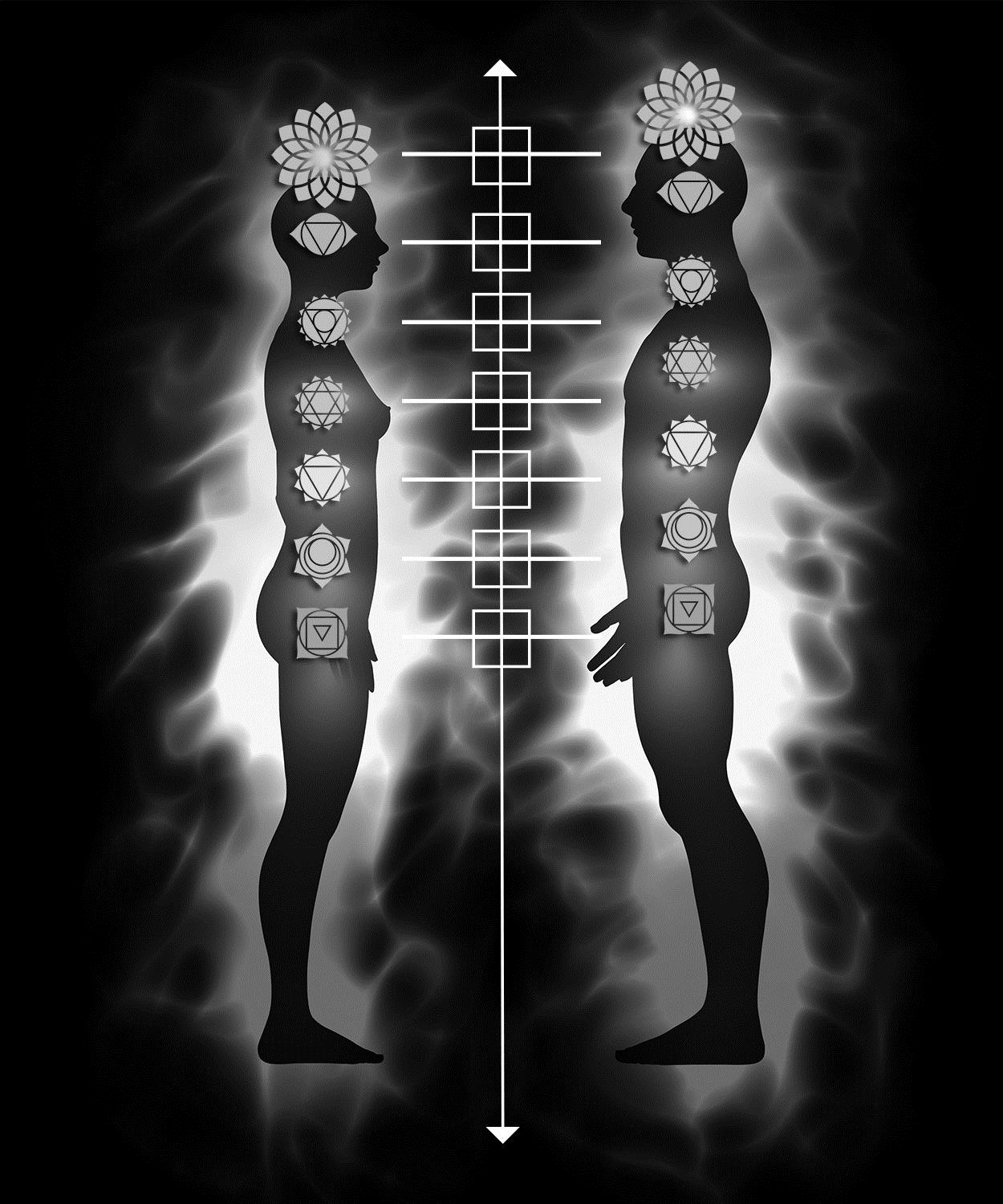
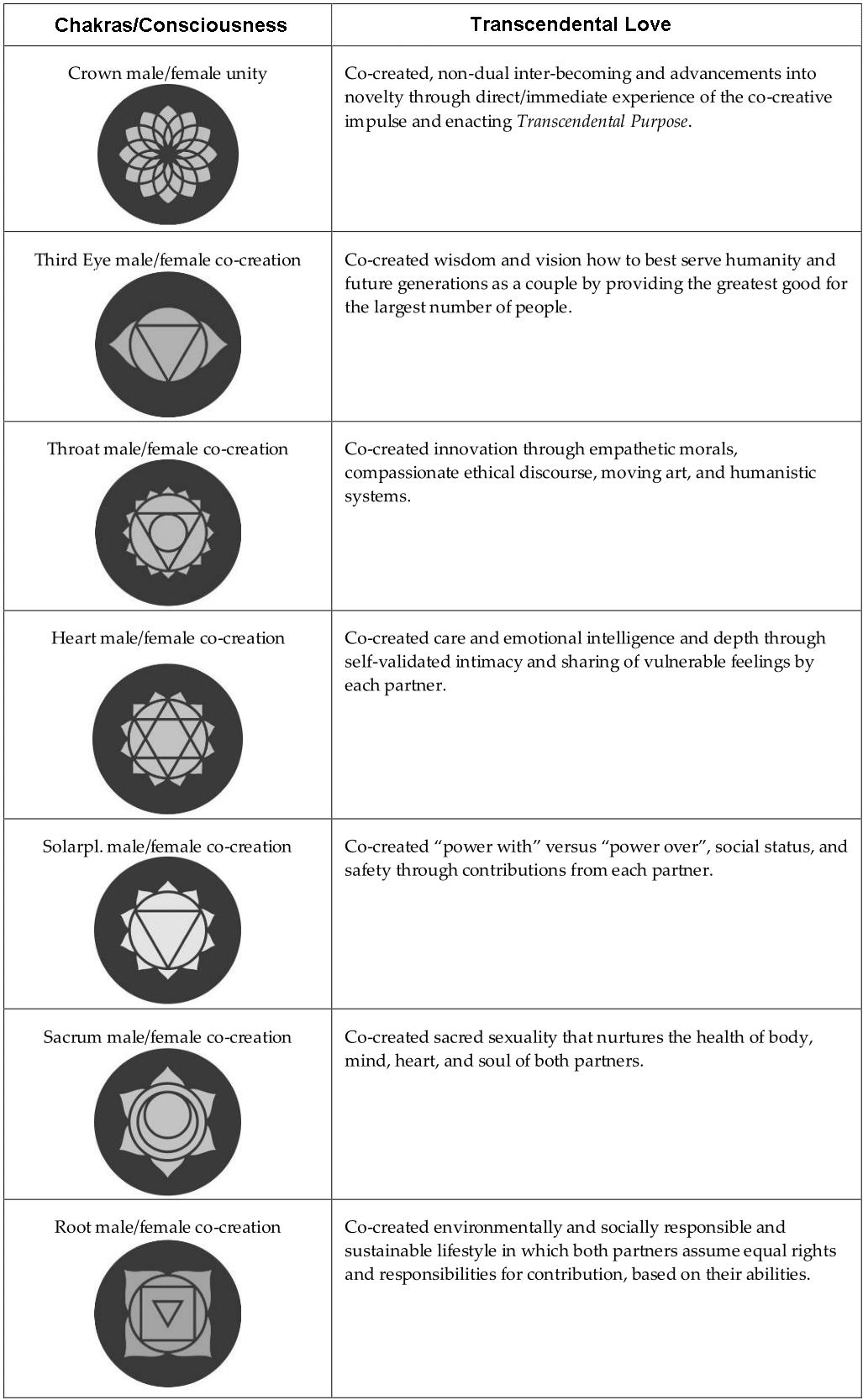
Another, more technical way of viewing this is shown in the image below:
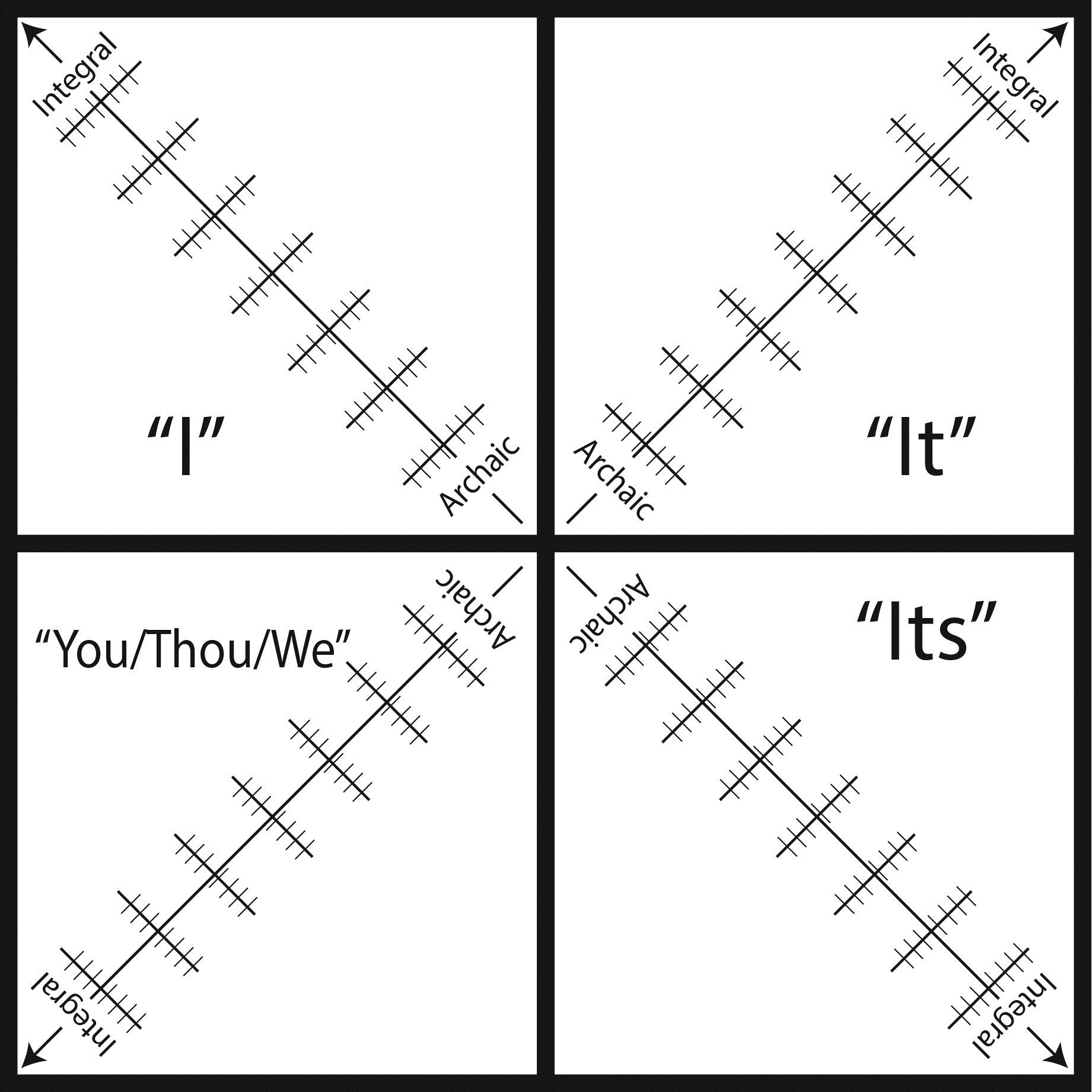
Each quadrant shows seven levels of consciousness development from Archaic (in the center) to Integral (in each outside corner). Each of the seven levels holds the potential for the expression of the seven chakras (shown as the short lines that look like old TV antennas.)
Please register below to join our conversation on April 21st from 10 - 11 PDT:
[i] The sixth sense is another term for extrasensory perception. Extrasensory perception (ESP) would involve the reception of information not gained through the recognized senses and not internally originated. According to the National Science Foundation extrasensory perception is listed as pseudoscience.
The expression "sixth sense" is a misnomer that falsely suggests that there is only one additional sense besides the traditional five senses of sight, hearing, touch, smell, and taste, a classification attributed to Aristotle. Humans have at least five additional senses that include: nociception (pain); equilibrioception (balance); proprioception and kinaesthesia (joint motion and acceleration); sense of time; thermoception (temperature differences); and possibly an additional weak magnetoception (direction).
https://en.wikiversity.org/wiki/What_is_the_sixth_sense%3F
[ii] According to world-renowned gender communication expert Deborah Tannen, men speak to determine and achieve power and status. Women talk to determine and achieve connection. Given that in American society speaking is considered the power position, it is no wonder that men interrupt to take the floor more often. In using conversation to enhance connection, women are much less likely to interrupt, as it is seen as disrespectful.
Numerous studies support the claim of women in the workforce who argue that men interrupt them far more often than the reverse. It was shown in a 2014 study at George Washington University that when men were talking with women, they interrupted 33 percent more often than when they were talking with men. The men interrupted their female conversational partners 2.1 times during a three minute conversation. That number dropped to 1.8 when they spoke to other men. The women in the study rarely interrupted their male counterparts—an average of once in a three minute dialogue.
Men, think twice before you interrupt. Are you interrupting to become the speaker and gain power? How will you look to everyone else in the room? Are you interrupting to get clarity? If so, make sure you ask a clear question and allow the speaker to regain the floor. Are you interrupting because you think you will forget what you want to say? Jot key words on your notepad for use later, instead of interrupting.
Women, if you are interrupted for any reason other than someone asking for clarification, say to the interrupter, “There are a few more essential points I need to make. Can you delay a moment while I do that?” or “I know I will appreciate your feedback, but can you hold off until I’m done?” Use strategies that men already use. Use shorter sentences so your breaths in between aren’t as long, making it harder to interrupt, and speak with conviction using words like ‘know’ instead of ‘believe’ and ‘will’ instead of ‘might.’ Carol Kennedy and Carl Camden’s study on “Interruptions and Nonverbal Gender Differences” found that men tended to interrupt women more often when they lean away, smile and don’t look at the person they are speaking to. So look ‘em in the eye, lean in and take yourself seriously if you want to be heard.
Finally, give each other a break. Interruptions are rarely meant to be personal. What is important to remember is that our communication norms are different, so let’s learn what that means and help each other through the rough spots with civil discourse and listening.
[i] According to sociologist Max Weber, [social] stratification may occur amongst at least three complex variables: (1) Property (class): A person's economic position in a society, based on birth and individual achievement. (2) Prestige (status): A person's prestige, or popularity in a society. This could be determined by the kind of job this person does or wealth. (3) Power (e.g. political party): A person's ability to get their way despite the resistance of others. For example, individuals in state jobs, such as an employee of the Federal Bureau of Investigation, or a member of the United States Congress, may hold little property or status but they still hold immense power. http://en.wikipedia.org/wiki/Sociology
[ii] A natural hazard is a natural phenomenon that might have a negative effect on people or the environment. Natural hazard events can be grouped into two broad categories. Geophysical hazards encompass geological and meteorological phenomena such as earthquakes, volcanic eruption, wildfire, cyclonic storms, flood, drought, and coastal erosion. Biological hazards can refer to a diverse array of disease and infestation. https://en.wikipedia.org/wiki/Natural_hazard
The 2011 American psychological thriller/drama “Take Shelter” gives a great example of a paranoid men trying to protect his family from geophysical hazards (storms).
[iii] There is a big difference between receiving “criticism” from a partner for his or her own sake, especially when we feel pulled down towards un-freedom instead of being lifted up towards more freedom, and feedback from someone who fully accepts us as we are and sees unrealized potentials that would benefit us and the world, and leaves us the choice to take the feedback or leave it without judgment or punishment. As Jack Nicholson as Melvin Udall says to Carol in the movie “As Good as it Gets”: “You make me want to be a better man.”
[iv] Chakras 1 - 7
1 – Root, Ground or Base Chakra = Survival, Earth, Roots, Grounding, Body, Food, Matter, Beginning.
2 – Sacral Chakra = Sexuality, Feelings, Sensations, Emotion, Movement, Pleasure, Nurturance, Gender Polarities.
3 – Solar Plexus Chakra = Power, Autonomy, Will, Identity, Confidence, Self-Discipline.
4 – Heart Chakra = Care, Warmth, Empathy, Compassion, Joy, Kindness, Generosity, Healing.
5 – Throat Chakra = Creativity, Self-Expression, Sound, Communication, Reason, Knowledge, Truth.
6 – Brow Chakra = Intuition, Vision, Seeing, Imagination, Visualization, Self-Reflection, Meditation.
7 – Crown Chakra = Mystical Oneness and Unity, Serenity, Transcendence, Immanence, Non-Duality.
[v] The concept of Differentiated Unity emerged in classic Greek philosophy with Plato who saw the different virtues of the Philosopher as part of one soul (or God if you will.) In modern sociology the term is often used to describe individual humans as parts of the unity of a couple or the unity of societies. In Integral theory it means that every individual whole is part of a larger whole or unity.
[vi] The limbic system is not a separate system but a collection of structures that includes the olfactory bulbs (smell is very important in the sexual selection process), hippocampus, hypothalamus, amygdala, etc. The limbic system supports a variety of functions including emotion, behavior, motivation, long-term memory, and olfaction. Emotional life is largely housed in the limbic system, and it has a great deal to do with the formation of memories.
[vii] “What we really seek is familiarity — which may well complicate any plans we might have had for happiness. We are looking to recreate, within our adult relationships, the feelings we knew so well in childhood. The love most of us will have tasted early on was often confused with other, more destructive dynamics: feelings of wanting to help an adult who was out of control, of being deprived of a parent’s warmth or scared of his anger, of not feeling secure enough to communicate our wishes. How logical, then, that we should as grown-ups find ourselves rejecting certain candidates for marriage not because they are wrong but because they are too right — too balanced, mature, understanding and reliable — given that in our hearts, such rightness feels foreign. We marry the wrong people because we don’t associate being loved with feeling happy.”
www.nytimes.com/2016/05/29/opinion/sunday/why-you-will-marry-the-wrong-person.html
[viii] There are certainly practices that can heighten the chances of passion, dependence and intimacy to emerge, such as eye gazing, physical touch, vulnerable sharing of feelings, psychological healing and shadow work (Calling In “The One” and Conscious Uncoupling are two great books and processes for women to remove blocks that prevent them from opening up to men and relationships), mirroring, sharing activities, creating new experiences, and spiritual practices such as meditation. But these alone are no guaranty, especially if they are connected to magical thinking and unrealistic expectations. The wisdom that “enlightenment is an accident, and meditation makes us accident prone” also applies to falling in love.
[ix] As described in Integral Relationships: A Manual for Men, we need to differentiate between biologically hardwired attractors that have persisted throughout human history, like certain body features that indicate fertility and the ability to bear healthy children, or to protect and provide, and personal preferences which have to do with positive and traumatic childhood and adult experiences, as well as the ones which are clearly culturally constructed, e.g. American women expecting men to buy an expensive diamond ring when they propose and having a sense of entitlement, which we don’t find to that degree in European women. On the other hand, American women make more efforts to augment their sexual attractiveness. These American ways of attraction are increasingly spread around the world through movies and the internet.
[x] To give but one of many examples about this dynamic, the widely respected Los Angeles based relationship expert Alison Armstrong writes in her popular book Making Sense of Men: A Woman's Guide to a Lifetime of Love, Care and Attention from All Men: Four qualities in women (shiny hair, shapely body, sensuality, and sexual energy) will attract men who will want to have sex with them. Once women have charmed and enchanted men with their self-confidence, authenticity, passion, and receptivity, men will fall in love with them and make them happy by spending time, taking care, protecting, and contributing/providing.

